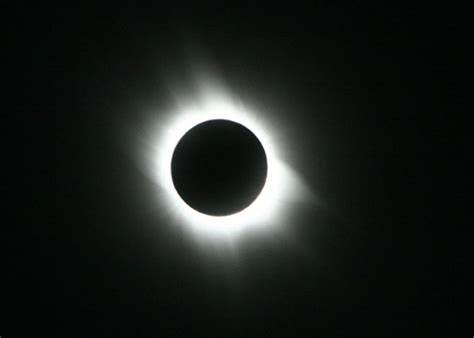(单词翻译:单击)
Solar eclipses tend to be pretty big news.
每次日食出现都会引起轩然大波。
The 2017 one in North America was hugely memorable for millions of people, including the SciShow team.
北美洲2017年出现的那次日食让很多人印象深刻,包括我们节目组。
And the 2019 one in South America was equally amazing and Instagram-worthy.
那么美洲2019年的那次日食也同样让人印象深刻,在Ins上也引起了轩然大波。
But during those events, the sky isn't the only thing people were looking at.
不过,每次日食出现的时候,天空并不是人们观测的唯一事物。
They were also fascinated by these crescent-shaped lights that appeared on the ground, most noticeably underneath trees.
人们还会对地面上出现的月牙形光芒感到痴迷,一般在树下会出现这种光芒。
The lights are one of the most fun parts of any solar eclipse, and the science behind them is pretty good, too.
这些光也是日食中最有趣的部分之一,其背后的科学原理也很棒。
The biggest thing causing these lights is called the pinhole camera effect.
引起这些光影的最重要原因就是小孔成像原理。
Like the name says, it was originally used to describe pinhole cameras, which work by letting light through a tiny hole in a screen.
小孔成像原理,顾名思义,一开始是用来描述小孔成像的,其机理是让光通过屏幕上的一个小孔。
But the same physics applies when light from an eclipse passes through the spaces between tree leaves.
这个原理也适用于如下情况:日食的光在树叶之间的空间穿梭。
On the most basic level, light comes from the Sun, passes through those gaps, and then hits a projection surface, usually, the ground.
从基本层面来说,太阳散发出的光会穿过这些间隙,抵达放映面。放映面通常情况下是地面。
But the important part is that not every ray of light is able to pass through.
但最重要的是:并不是每一束光都能穿过。
The only rays that reach to the ground are the ones angled in just the right way to make it through the spaces between the leaves.
而抵达地面的光束是角度恰好合适的,正好能穿过树叶之间的间隙。
And much of that light takes a very specific path.
其中很大一部分光束都有特定的路线。
It starts from one side the Sun, travels through the gap in the leaves, and hits the other side of the projection surface.
光束从太阳散发出来后,穿过了树叶之间的间隙,然后抵达了放映面的另一面。
So light that comes from the left side of the Sun ends up on the right side of the patch of ground, and vice versa.
所以,来自太阳左侧的光束最后会在地面上某块的右侧出现,反之亦然。
This creates an image of the Sun that's both upside-down and backwards.
这就会产生一幅太阳的画面,上下左右颠倒的画面。
And it's why those little blobs of light look so much like the solar eclipse happening way up in the sky:
正因如此,这些光斑看起来特别像天空中的日食。
They're tiny images of the eclipse itself.
其实,它们是日食缩小版的样子。
Technically, this means you can observe this phenomenon regardless of whether an eclipse is happening or not.
严格来说,这就意味着:无论日食是否发生,我们都能观察到这样的现象出现。
It's just that the Sun, without the Moon in front of it, looks like a circle, so its projected image is just a circle. Pretty nondescript.
说白了就是:太阳前面没有月亮挡着的时候,看起来像个圆圈,所以投射出来的样子就是一个圆圈。这一点很稀松平常。
It's only once the Moon starts getting in the way that things become all interesting and pretty.
只有当月亮挡住太阳的时候,才开始变得有趣而美妙。
The cool thing about these images isn't just their shape, though, it's also the fact that they're really crisp and clear.
不过,这些图像的酷炫之处不只在于其形状,还在于图像格外清楚。
Like, look at these lights compared to the blobs you normally see underneath trees.
比如,如果将在树下看到的光斑与光束做对比的话,
The normal lights are fuzzy, while the eclipse ones are sharp little moon-shaped things.
就会发现:正常的光束是很模糊失真的,而日食的光斑轮廓鲜明,形状很像月亮。
That happens for at least two additional reasons.
这一现象发生,还有另外2个原因。

One is that there's less ambient light during an eclipse.
其一是:日食期间,周围的光更少一些。
Normally, sunlight gets refracted and bounces around in our upper atmosphere.
正常情况下,日光在大气层上空会发生折射和反射。
That gives the sky its nice blue glow, but that glow is another source of illumination, which makes the lights and shadows we see pretty fuzzy.
因此,天空有了漂亮的蓝色的光,但这一蓝色的光也会成为光照度的另一源头,这就会让光影变得特别模糊。
As a solar eclipse approaches totality and the Moon moves completely in front of the Sun, that additional glow is dramatically reduced.
在日食演变为日全食的过程中,月亮会渐渐移到太阳正面,所以这部分额外的光晕就彻底摒除了。
That means you don't get as much interference, so you get much cleaner, photo-worthy images.
也就是说,不会受到这部分额外光晕的影响,得到的图片也就更清晰,更有作用。
The other reason these things get so sharp close to totality is because the visible portion of the Sun becomes narrower.
图像在接近日全食的时候愈发清晰,还有一个原因:太阳可见的部分越来越窄了。
Normally, the sharpness of a shadow depends on how far away you are from a light source:
正常情况下,阴影是否清晰取决于距离光源的距离:
If you're really close to it, the shadow will be sharper, and if you're farther away, it will be more fuzzy.
如果距离光源足够近的话,阴影部分就会更加清晰。反之,则会很模糊。
But changing the size of the light source can have the same effect.
但改变光源的大小也会有相同的效果。
When you decrease the size of your light source relative to the thing that's casting a shadow, like, by covering up part of the Sun, the shadows change.
当光源相较于遮挡物体的相对大小减小时(比如遮住太阳的一部分),阴影区就会发生变化。
The ratio of things that are totally in shadow versus only partly in shadow increases, and that gives those eclipse lights on the ground sharper edges.
随着阴影区比重的增加,地面上日食所形成的光,其边缘部分就会更加清晰。
So the next time you're experiencing a solar eclipse, take some time to look down.
所以,大家下次碰到日食现象的时候,请花些时间低头看哦。
There's a lot that those funny-looking lights can teach you.
这些有趣又好看的光会让大家学到很多的。
And hey, if you're not willing to wait until the next eclipse, you're not out of luck.
如果有些同学不想等到下次日食的话,也有福利哦。
At night, LED streetlights shining through tree leaves can project some pretty cool pinhole images, too.
晚上的时候,LED街灯会在树叶间穿梭传播,也可以投影出很酷的针孔成像。
So ultimately, solar eclipses are cool in a lot of ways, but in this case, they help highlight some of the amazing phenomena that surround us all the time!
所以,总而言之,日食从多角度来看都是很酷的现象,也让我们更加关注日常生活中每秒的同原理现象。
I hope you get the chance to check out these amazing shadows the next time you experience a solar eclipse,
我希望大家下一次遇到日食的时候有机会感受一下那每秒的阴影区。
especially since looking at shadows is a great way to see what's happening without looking at the sun.
尤其是通过阴影区就能看到日食进度而无需直接观察日食的时候。
Because, in case you've forgotten, that is a really bad idea, and we have whole video that explains why which you can watch next.
贴心提示:因为毕竟由完整的视频可供大家观赏。虽然直接看视频并不是个好主意。


